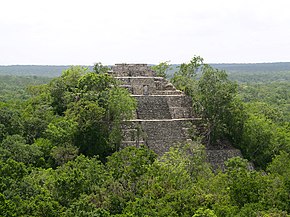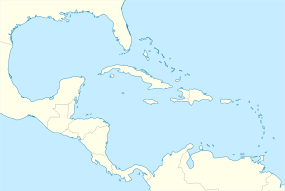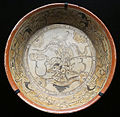Calakmul
| Prehistoric city Calakmul |
|
|---|---|
|
UNESCO world heritage |
|

|
|
| Main pyramid of Calakmul, structure I. |
|
| National territory: |
|
| Type: | Culture / nature |
| Criteria : | i, ii, iii, iv, vi, ix, x |
| Reference No .: | 1061 |
| UNESCO region : | Latin America and the Caribbean |
| History of enrollment | |
| Enrollment: | 2002 (session 26) |
| Extension: | 2014 |
Coordinates: 18 ° 6 ′ 20 ″ N , 89 ° 48 ′ 37 ″ W.
Calakmul (also Kalakmul ) was a powerful Mayan city during the Classical Period . Together with El Mirador and Tikal , Calakmul is one of the largest Mayan cities ever discovered.
On March 30, 2015, the memorial was included in the International Register of Cultural Property under the special protection of the Hague Convention for the Protection of Cultural Property in the Event of Armed Conflict .
location
Calakmul is located around 300 km southeast of the city of Campeche (Mexico) in the state of the same name . From the city of Chetumal to the east, it is only about 235 km to the south-west.
construction
Calakmul extended over an area of about 30 square kilometers and had over 100 colossal buildings; a total of more than 5000 buildings are known. The so-called "structures" I and II are dominant here. The latter is around 45 meters high. Most of Calakmul, however, has not yet been excavated or further explored. One can only speculate about the number of inhabitants. For the city center, for example, a population of around 50,000 is assumed. Due to the size of Calakmul, the total population should have been comparable with the dimensions of the metropolitan region of Tikal .
history
Calakmul's historical name was "Chan" ( chan ), the emblem glyph depicts a snake's head. The literal translation is also "snake". The area of the city of Calakmul was already settled in the pre-classical period; The foundations of the two main pyramids also date from this time. However, the city only gained importance with the introduction of royal rule around 500 AD. Calakmul quickly rose to become the leading great power in the region in the 6th century.
Soon afterwards, however, Calakmul came into conflict with the second great power of the southern lowlands, the city of Tikal . The trigger was the installation of a new king Aj Wosal in 546 in the city of Naranjo, which was actually controlled by Tikal . Fifteen years later, the same thing happened in Los Alacranes . Calakmul's intervention in the conflict between Tikal and his vassal Caracol in favor of Caracol in 562 finally resulted in open war. Tikal suffered a severe defeat, from which the city did not recover for over a hundred years, and a puppet king from Calakmul was installed. In the following years, the rulers of Calakmul built a veritable network of vassal states. At the same time raids were made on states allied with Tikal. Palenque , located far to the west, had to endure two raids in 599 and 612, in which a large part of the city was destroyed and almost the entire political upper class was killed.
After the death of Aj Wosal von Naranjo, his successor tried to remove the city from the hegemony of Calakmul. Calakmul vigorously opposed this in 631 by attacking Naranjo with the help of Caracol and kidnapping the ruling ruler. Five years later, Yuknoom Ch'een II , called the Great , became King of Calakmul. He led the city to the height of its power.
Meanwhile, the upper class of Tikal had split. After an internal power struggle, that branch of the ruling family that demanded the independence of Calakmul prevailed and helped Nuun U Jol Chaak to the throne. Another part of the ruling family fled to Dos Pilas in 648 and established an independent kingdom there, which on the one hand ruled over the city of Tikal, but at the same time claimed the protection of Calakmul. Calakmul consequently launched an attack on the renegade Tikal. The king, expelled from there, started another war on his return, which, however, only resulted in Tikal submitting again.
The war against Tikal had shown the military and political power of Calakmul. Yuknoom forced numerous cities under the rule of Calakmul, partly through war, but partly also through diplomacy, as in the case of Naranjo. When Yuknoom died in 686, Tikal was politically and militarily completely isolated, but not defeated. Nevertheless, the indirect rule over other cities was also Calakmul's greatest weakness. In 695 the then ruler Yuknoom Yich'aak K'ak ' , the son of Yuknoom the great , was decisively defeated in a battle near Calakmul and Calakmul was presumably occupied temporarily by Tikal. From this point on, the city began to decline. Tikal now systematically defeated one vassal of Calakmul after the other and thus gradually forced the city into political insignificance, which is proven by the increasingly rare mentions of Calakmul in the texts of other cities. Between 733 and 736, Calakmul was again directly attacked by Tikal, as a result of which Calakmul's king Yoknoom Took Ka'will was probably captured.
The last inscription with a calendar date in Calakmul itself dates to January 20, 909, but it is believed that the city was inhabited for some time longer, as indicated by some roughly worked small steles.
research
In 1931 the city, often referred to in ancient texts as the "Kaan" or "Kingdom of the Snake", was rediscovered by the American Cyrus L. Lundell . Sylvanus Griswold Morley studied the then known inscriptions the following year. The first scientific report comes from Karl Ruppert and John H. Denison, Jr. Many of the 117 discovered steles are hardly decipherable today because the limestone used was of relatively poor quality. A significant number of steles were removed by treasure hunters before modern research began and sold illegally on the international art market. A Mexican project has been working under William Folan in Calakmul since the 1980s, later supplemented by another under Ramón Carrasco Vasgas from the Instituto Nacional de Antropología e Historia (INAH). In 1997, the burial chamber of King Yuknoom Yich'aak K'ak 'was found in Structure 2. In 2009 a magnificently preserved mural in the form of picture friezes was discovered by researchers around Carrasco Vasgas, which unusually depicts the diverse life of the simple population. This ruin, discovered in the jungle in the still unexplored northern part of the city, is of unique importance for the study of Mayan life. In more than 40 scenes, the frescoes inside a collapsed pyramid illuminate everyday processes (preparing and consuming food from corn, offering pottery, handling ropes, carrying loads), each with a hieroglyph on the activity.
photos
See also
literature
- Nikolai Grube (Ed.): Maya. God kings in the rainforest. Könemann-Verlag, Cologne 2000, ISBN 3-8290-1564-X .
- Simon Martin / Nikolai Grube: Chronicle of the Maya Kings and Queens. Deciphering the Dynasties of the Ancient Maya. Thames & Hudson, 2nd ed., London 2008, ISBN 978-0-500-28726-2 , pp. 100-115.
- Linda Schele , David Freidel : The unknown world of the Maya. The secret of their culture deciphered. Weltbild Verlag, Augsburg 1995, ISBN 3-89350-737-X .
Web links
- Calakmul on the UNESCO World Heritage Center website ( English and French ).
- Map and photos of the temple ruins
- Calakmul at Yucatan-Guide.de
- mesoweb.com (engl.)
- Instituto Nacional de Antropología e Historia - official site (span.)
- Calakmul Epigraphic Research Project, University of Pennsylvania Museum
Individual evidence
- ↑ International Register of Cultural Property under Special Protection. UNESCO, July 23, 2015, accessed June 2, 2016 .
- ↑ See Simon Martin / Nikolai Grube: Chronicles of Mayan Kings and Queens . Thames & Hudson, London 2000, p. 115
- ^ Karl Ruppert, John H. Denison Jr .: Archaeological reconnaissance in Campeche, Quintana Roo, and Peten . Carnegie Institution of Washington, Publication 543. Washington DC 1943, pp. 13-23, 100-122.
- ^ In: Proceedings of the National Academy of Sciences (PNAS). Washington 2009. doi : 10.1073 / pnas.0904374106 ISSN 0027-8424 quoted. after A Mayan Picture Book. In: scienceticker.info. November 10, 2009. Retrieved November 10, 2009 .










